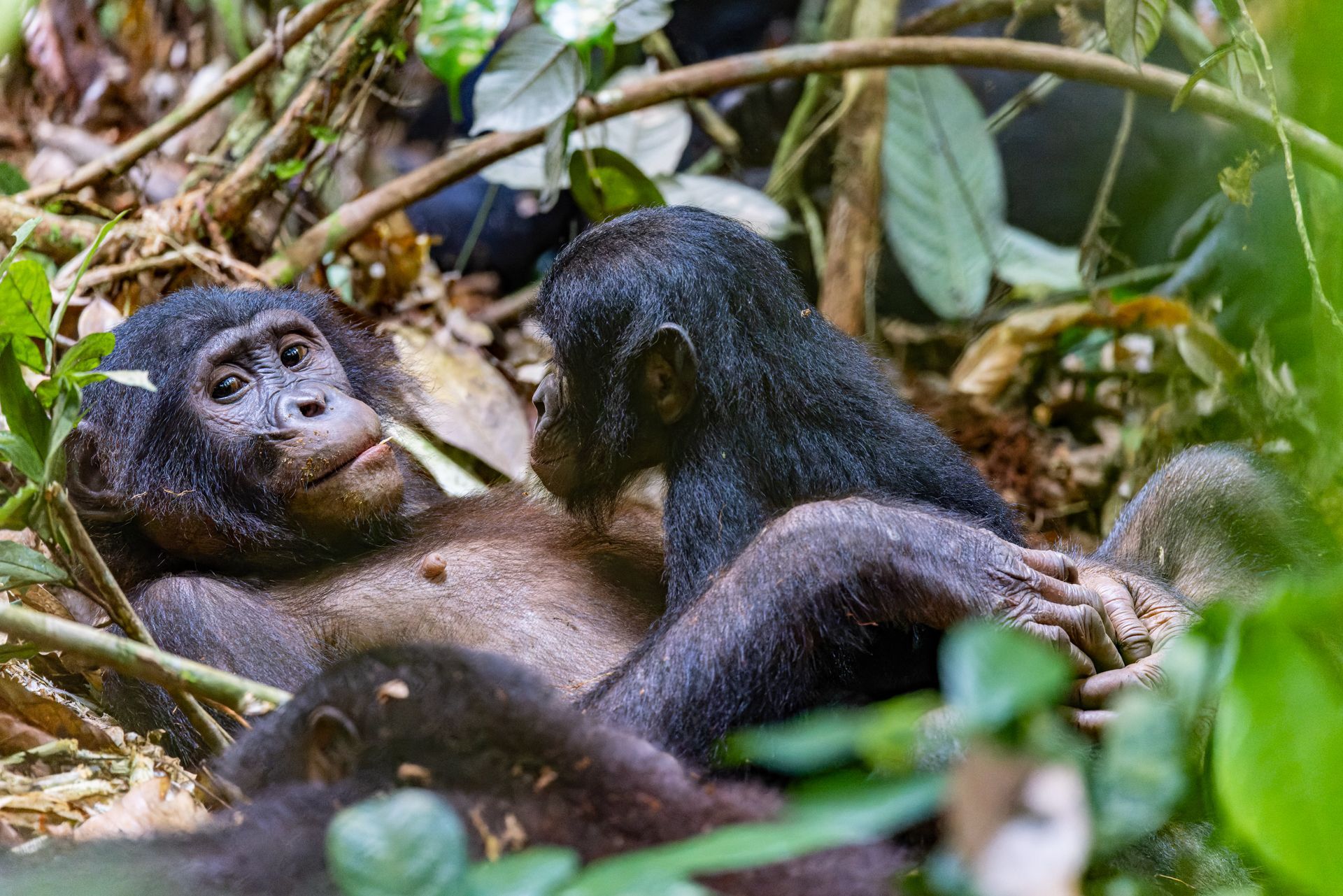Newsletter

Die Macht des Matriarchats Warum die Dinge an diesem Nachmittag so entgleisen, wird für immer ein Rätsel bleiben. Seit dem Morgen sind Sonya, Sofia und Leonardo mit der Westgruppe unterwegs und nehmen online Verhaltensdaten auf. Gellende Schreie unterbrechen die Routine und alle drei rennen los. An der Stelle, an der Tumult ausgebrochen ist, können sie zunächst kaum etwas erkennen. Mehrere Bonobos drängen sich um ein Tier am Boden. Es dauert ein paar Minuten, bis die Sichtverhältnisse ausreichen, um Individuen auszumachen. Am Boden liegt Hugo, ein erwachsener Mann, umringt von Polly, Tao, Ngola, Bella, und Djulie. Die fünf Frauen wechseln sich bei ihren Attacken ab. Es hagelt Schläge und Bisse, mehrmals versuchen die Frauen den Mann auf den Rücken zu drehen. Als das gelingt, ist er den zornigen Frauen schutzlos ausgeliefert. Hugo verliert mehrere Finger und ein Ohr und hat tiefe Bisswunden an den Hoden und am Bauch. Nach einer halben Stunde lassen die Angreiferinnen von ihm ab. Jetzt hockt er gekrümmt am Boden und presst gellende Rufe aus dem malträtierten Körper. Er hat kaum noch Haare, sein Gesicht ist entstellt. Als die Gruppe schließlich den Platz verlässt, verschwindet auch er im Unterholz. Seitdem fehlt von Hugo jede Spur. Möglich, dass er zum Einzelgänger geworden ist. Wahrscheinlicher ist jedoch, dass er den Angriff nicht überlebt hat. Gewalt in dieser Form ist in der Bonobogesellschaft selten. Was auch immer der Auslöser gewesen sein mag, er hat zu Gewalttätigkeiten geführt, die so gar nicht in das Bild einer friedfertigen Primatengesellschaft passen. In der Regel reicht entschlossenes Auftreten und die zahlenmäßige Übermacht weiblicher Gruppenmitglieder aus, um Konflikte zwischen den Geschlechtern zu beenden. Wenn aber im Ernstfall „Brusttrommeln“ in physische Gewalt umschlagen kann, erhöht sich das potentielle Risiko für männliche Einzelkämpfer. Die Bündnisse der Frauen sind also weit mehr als Schutzgemeinschaften. Eskalierende Konflikte wurden auch schon in anderen Bonobo-Populationen beobachtet und gehören demnach ins Verhaltensrepertoire der Art. Die geschilderte Attacke wird an der pazifistischen Reputation der Art Pan paniscus wenig ändern. Aber sie macht einmal mehr deutlich, welche Schlagkraft die Allianzen weiblicher Bonobos haben und warum männliche Artgenossen diplomatische Lösungen bevorzugen. The power of matriarchy Why things go so wrong that afternoon will remain a mystery forever. Since the morning, Sonya, Sofia and Leonardo have followed West group, recording behavioural data online. Shrill cries interrupt the routine and all three rush off. At first, they can hardly see anything where the commotion has broken out. Several bonobos are crowding around an animal on the ground. It takes a few minutes before visibility is good enough to recognize individuals. Hugo, an adult male, is lying on the ground, surrounded by Polly, Tao, Ngola, Bella and Djulie. The five females take turns attacking him. They rain down blows and bites, repeatedly trying to turn the male onto his back. When they succeed, he is defenseless against the furious females. Hugo loses several fingers and an ear and has deep gashes on his testicles and stomach. After half an hour, the attackers leave him alone. Hugo now crouches on the ground, curled up, letting out piercing cries from his battered body. He has hardly any hair left and his face is disfigured. When the group finally leaves the spot, he also disappears into the undergrowth. Since then, there has been no trace of Hugo. It is possible that he has become a loner. However, it is more likely that he did not survive the attack. Violence of this kind is rare in bonobo society. Whatever the trigger may have been, it released violent acts that do not fit in with the image of a peaceful primate society. Usually, their determined attitudes and the numerical superiority of female group members are sufficient to end conflicts between the sexes. However, if ‘chest drumming’ can turn into physical violence in serious situations, the potential risk for a male increases. The alliances formed by the females are therefore much more than just protective communities. Escalating conflicts have also been observed in other bonobo populations and are therefore part of the species' behavioural repertoire. The attack described above will do little to change the pacifist reputation of Pan paniscus but highlights the power of female bonobo alliances and why male members prefer diplomatic solutions.
Bonobos verstehen Es ist Samstag der 18. Oktober, die Lange Nacht der Museen in München. Am Eingang der Generalverwaltung der Max-Planck-Gesellschaft zieht eine Leuchttafel die Aufmerksamkeit der Passanten auf sich - ein Bonobo im satten Grün des Regewaldes – ein Bild aus einer anderen Welt. In der Eingangshalle finden Besucher den Nachbau eines Urwaldcamps. Forscher sind mit Besuchern im Gespräch, informieren über ihre Arbeit und persönliche Erlebnisse mit Bonobos. Dann kommt der Themenvortrag von Barbara Fruth, Gruppenleiterin am Max-Planck-Institut für Verhaltensbiologie in Konstanz und Vorsitzende von Bonobo Alive. Der Hörsaal ist gesteckt voll als sie die Besucher mit auf die Reise in den Wald von LuiKotale nimmt. Die Bonobos stehen im Mittelpunkt, aber es geht auch um ihre Heimat, die Demokratische Republik Kongo, ein Land der Superlative, letzte grüne Lunge des Planeten und die große Hoffnung darauf, Biodiversität auf dem afrikanischen Kontinent zu bewahren. Forschungsberichte aus dem kongolesischen Regenwald haben Unterhaltungswert, provozieren aber auch Fragen nach dem Ursprung jener Verhaltensweisen freilebender Bonobos, die so gar nicht in das vertraute Koordinatensystem evolutionärer Theorien passen. Bonobos zu verstehen (so der Titel der Präsentation), ist alles andere als einfach – das wird den Zuhörern schnell klar. Was die 1800 Besucher am Ende sonst noch an Eindrücken mitnehmen ist sicher sehr unterschiedlich. Das „Internet der Tiere“, ein beeindruckender Film über den Kosmos weltweiter Tierwanderrungen. Die Funktionsweise von Miniatursendern mit denen Schmetterlinge bestückt werden. Die Strahlkraft der intimen Naturfotos von Christian Ziegler. Das gemeinsame Anliegen der Veranstalter auf eine einfache Formel gebracht lautet: Forschung war und ist wichtig, sie schafft Verständnis für uns und unsere Umwelt, entdeckt Neues und kann helfen, Lebewesen zu bewahren, mit denen uns weit mehr als nur genetische Verwandtschaft verbindet. Understanding bonobos It is Saturday, October 18, the Long Night of Museums in Munich. At the entrance to the head quarter of the Max Planck Society, an illuminated sign catches the attention of passersby—a bonobo in the lush green of the rainforest—an image from another world. In the entrance hall, visitors find a replica of a field camp. Researchers talk to visitors, informing them about their work and personal experiences with bonobos. Then comes the keynote speech by Barbara Fruth, group leader at the Max Planck Institute of Animal Behavior in Konstanz and chairwoman of Bonobo Alive. The lecture hall is packed as she takes visitors on a journey to the forest of LuiKotale. The bonobos are the focus, but the lecture also covers their homeland, the Democratic Republic of Congo, a country of superlatives, the last green lung of the planet, and the great hope for preserving biodiversity on the African continent. Research reports from the Congolese rainforest are entertaining, but they also raise questions about the origins of the behavior of wild bonobos, which do not fit into the familiar coordinate system of evolutionary theories. Understanding bonobos (the title of the lecture) is anything but easy—this quickly becomes clear to the audience. The impressions that the 1,800 visitors take away with them at the end are certainly very different. The “Internet of Animals,” a splendid film about the cosmos of global animal migration. The miraculous function of miniature transmitters, small enough to be attached to butterflies. Christian Ziegler's intimate nature photographs. The common take-home message is that research was and is important; it creates understanding for us and our environment, discovers new things, and can help preserve living creatures with which we share much more than just genetic kinship.

Würdigung für 25 Jahre Naturschutz im kongolesischen Regenwald Naturschützer engagieren sich für bedrohte Tierarten und deren natürlichen Lebensraum. Dieses Image lässt an Menschen in Funktionskleidung denken, die zu Fuß oder im Geländefahrzeug durch die Wildnis ziehen und mit Fernglas, Sprechfunk und – bisweilen – Schusswaffen ausgerüstet sind. Was das Bild nicht zeigt, sind die diplomatischen Mühen, die für erfolgreichen Naturschutz essentiell sind. Die größte Gefahr für das Überleben von Wildtieren sind oft jene Menschen, die den gleichen Lebensraum für sich beanspruchen und wer etwas für den Artenschutz tun will, muss sie für diese Idee gewinnen. Die Mission von Bonobo Alive ist der Schutz wilder Bonobos vor Jägern. Barbara Fruth, die Vorsitzende des Vereins, bemüht sich seit gut zwei Jahrzehnten darum, Menschen in der Demokratischen Republik Kongo davon zu überzeugen, dass sich Naturschutz nicht gegen die Bedürfnisse von Menschen richtet. Mit diplomatischem Geschick und einem Gespür für das bisweilen mythische Naturverständnis der ansässigen Bevölkerung, hat sie die potentiellen Jäger und deren Familien mit ins Boot geholt, hat Ausbildungsprogramme ins Leben gerufen, Frauen dabei unterstützt, ihre oft vernachlässigten Interessen in der Dorfgemeinschaft durchzusetzen, und kongolesischen Forschern dabei geholfen, die ersten Sprossen der Karriereleiter zu erklimmen. Mit ihrer Arbeit hat die Forscherin am Max-Planck-Institut für Verhaltensbiologie die Jäger davon überzeugen können, dass sie sich mit unlimitierter Jagd am Ende selber ins Bein schießen. Gleichzeitig haben die wilden Bonobos in der Pufferzone des Salonga Nationalparks ein sicheres Refugium gefunden, in dem ihnen nur noch Forscher auf den Fersen sind. Für ihr Engagement erhält Barbara Fruth im Oktober das Bundesverdienstkreuz, eine Ehrung die all jene einschließt, die die Arbeit des Vereins unterstützt haben ( https://www.ab.mpg.de/723085/barbara-fruth-awarded-order-of-merit ). Recognition for 25 years of nature conservation in the Congo forest Conservationists are committed to protecting endangered species and their natural habitats. This image conjures up thoughts of people in functional clothing, traveling on foot or in off-road vehicles across rough terrain, equipped with binoculars, walkie-talkies, and - sometimes - firearms. What the image does not show are the diplomatic efforts that are essential for successful conservation. The greatest threat to the survival of wild animals are often those people who claim the same habitat for themselves, and anyone who wants to do something to protect species must win them over to this idea. Bonobo Alive's mission is to protect wild bonobos from hunters. Barbara Fruth, the association's chairwoman, has been working for over two decades to convince people in the Democratic Republic of the Congo that nature conservation is not directed against human needs. With diplomatic skill and a keen sense of the sometimes mythical understanding of nature, she has brought potential hunters and their families on board, launched training programs, supported women in asserting their often neglected interests in the village community, and helped Congolese researchers to climb the first rungs of the career ladder. Through her work at the Max Planck Institute of Animal Behavior, the researcher has convinced hunters that by unlimited hunting, they are going shoot themselves in the foot. At the same time, the wild bonobos in the buffer zone of Salonga National Park have found a safe refuge where only researchers are on their trail. In October, Barbara Fruth will receive the Order of Merit of the Federal Republic of Germany for her commitment, an honour that includes all those who have supported the work of Bonobo Alive ( https://www.ab.mpg.de/723085/barbara-fruth-awarded-order-of-merit ).
Angeborener Mutterschutz Heranwachsende Säugetiere führen eine parasitäre Lebensweise. Alles was sie an Nährstoffen brauchen, holen sie sich von der Mutter. Dazu gehört auch der Aufbau des Skeletts, wofür große Mengen an Kalzium benötigt werden. Vor der Geburt holt sich der Fötus diesen Baustoff direkt von der Mutter. In den ersten Monaten nach der Geburt ist dann Muttermilch die alleinige Quelle für Wachstum und Entwicklung. Um den zusätzlichen Nährstoffbedarf zu decken, greifen Mütter ihre Substanz an und entziehen dem eigenen Skelett Mineralien. Bei Menschen und Haustieren kommt es dadurch zu einem Verlust der mütterlichen Knochensubstanz, ein kostspieliger Prozess, der erst dann ausgeglichen wird, wenn der Nachwuchs entwöhnt ist. Wie Wildtiere mit diesem Problem umgehen, ist bislang nicht bekannt. Können sie sich den kostspieligen Mineralstofftransfer von der Mutter zum Nachwuchs überhaupt leisten? Und wenn ja, wie vermeiden sie, dass der Abbau körpereigener Baustoffe nicht zum riskanten Verlustgeschäft wird? Bei Bonobos und anderen Menschenaffen vergehen Jahre, bis die Jungen sich selbst mit Futter versorgen können und es drängt sich die Frage auf, wie Mütter auf die ausbeuterische Strategie der Nachkommen reagieren. Der Ab- und Aufbau von Knochensubstanz hinterlässt Spuren und kann anhand bestimmter Markersubstanzen, die im Urin ausgeschieden werden, ermittelt werden. Messungen dieser Substanzen im Urin von schwangeren und säugenden Bonobomüttern, die im Wald von LuiKotale leben, ergaben erwartungsgemäß, dass im letzten Drittel der Schwangerschaft die Werte des Markers für den Knochenabbau ansteigen. Nach der Geburt waren die Werte jedoch niedriger als am Beginn der Schwangerschaft, ein Ergebnis was darauf hindeutet, dass Mütter sich gegen den weiteren Abbau der eigenen Knochen schützen können ( https://doi.org/10.1017/ehs.2025.10013 ). Mütter tragen ihre Kinder während des ersten Lebensjahres ständig mit sich herum und haben sie auch bei anspruchsvollen Kletterpartien in den Bäumen dabei. Unter solchen Bedingungen ist physische Leistungsfähigkeit gefragt und der Schutz vor Verlusten der Knochenmasse erscheint durchaus plausibel. Welcher Mechanismus den Knochenabbau der Mutter schützt, ist derzeit noch ein Rätsel. Congenital maternal protection Growing mammals lead a parasitic lifestyle. They get all the nutrients they need from their mother. This includes building the skeleton, which requires considerable amounts of calcium. Before birth, the fetus obtains this building material directly from the mother. In the first few months after birth, breast milk is the sole source for growth and development. In order to cover the additional nutritional requirements, mothers draw on their own reserves by extracting minerals from their own skeleton. In humans and domestic animals, this leads to a loss of maternal bone substance, a costly process that is only compensated for when the offspring are weaned. How wild animals deal with this problem is not yet known. Can they even afford the costly transfer of minerals from mother to offspring? And if so, how do they prevent the breakdown of endogenous building materials turning into a loss-making business? In bonobos and other great apes, it takes years before the young are able to provide themselves with food and the question arises as to how mothers react to the exploitative strategy of their offspring. The breakdown and build-up of bone substance leaves traces and can be determined on the basis of certain marker substances that are excreted in the urine. Measurements of these substances in the urine of pregnant and lactating bonobo mothers living in the LuiKotale forest showed, as expected, that the values of the marker for bone resorption increase in the final phase of pregnancy. After birth, however, the values were lower than at the beginning of pregnancy, a result that suggests that mothers can protect themselves against further degradation of their own bones ( https://doi.org/10.1017/ehs.2025.10013 ). Mothers carry their offspring with them constantly during the first year of life and do so when executing demanding climbs in the trees. Under such conditions, physical performance is particularly in demand and protection against bone loss therefore seems quite plausible. While this offers a reasonable - albeit hypothetical - answer, the mechanism that protects the mother against bone loss is still a mystery.
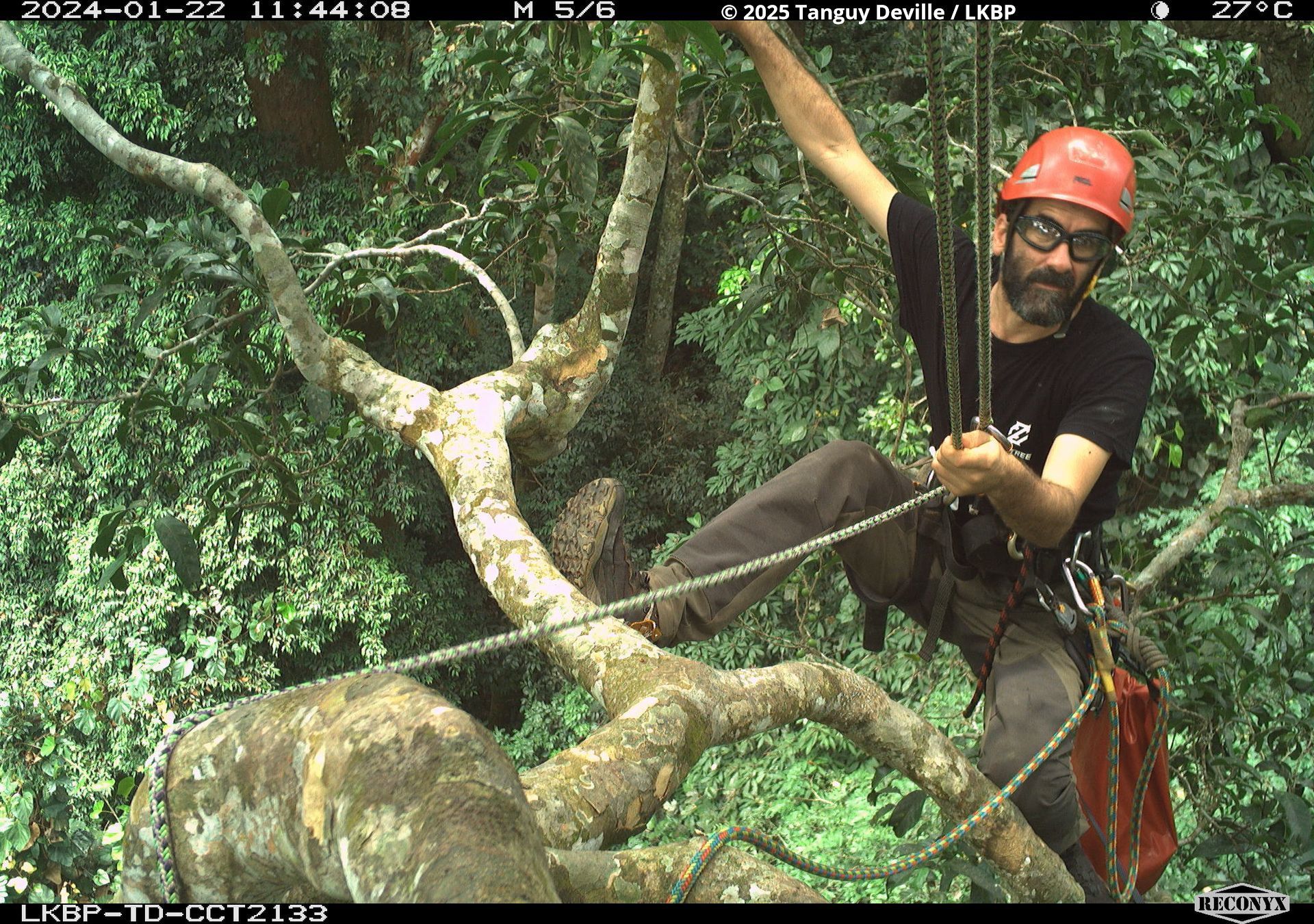
Stiftung unterstützt Pionierarbeit im Regenwald Der sprichwörtliche Artenreichtum tropischer Regenwälder erschließt sich dem menschlichen Beobachter erst mit Verzögerung. Dichte Vegetation behindert die Sicht und oft sieht man den Wald vor lauter Bäumen nicht. Wer sich im Pflanzengewirr einen Überblick verschaffen will, sollte sich mit Tierstimmen auskennen. Viele Tierarten verbringen den Großteil ihrer Zeit in den Baumkronen und was dort passiert, bleibt dem bodenständigen Zweibeiner oft verborgen. Wem der Aufstieg in die 20 bis 30 Meter hohen Baumriesen gelingt, der landet in einer neuen Welt. Fruchttragende Bäume haben starke Magnetwirkung und werden für Tage oder Wochen zu Verkehrsknotenpunkten. Bonobos sind nur eine von vielen Arten, die auf der Suche nach Früchten durch das Blätterdach streift (Bild 1). Ähnlich wie Menschen haben sie eine Vorliebe für „reifes“ Obst. Andere Arten langen schon früher zu und warten nicht, bis die Früchte ihren maximalen Nährstoffgehalt erreichen. Um das Rennen um die Ernte eines Urwaldriesen zu erfassen, braucht es ein 24/7 Beobachtungsdesign. Dafür bieten sich Kamerafallen an. Sie sind Tag und Nacht aktiv und erfassen nicht nur, wer sich gerade im Baum niederlässt, sondern erlauben auch Hochrechnungen zur Menge der konsumierten Nahrung. Mit Unterstützung der Stiftung Tier-, Natur und Artenschutz wird Tanguy Deville (Bild 2) eine Vielzahl fruchttragender Bäume mit Kameras ausstatten und so über viele Monate den Konsum von Früchten im Studiengebiet von LuiKotale erfassen. Tanguy ist Experte im Baumklettern und hat in vorangegangen Feldaufenthalten die technischen und logistischen Voraussetzungen für die anspruchsvolle Studie getestet. Den baumlebenden Konsumenten endlich einmal auf Augenhöhe zu begegnen, gehört für ihn zu den spannendsten Erfahrungen. Mit ihrem Engagement ermöglicht die Stiftung ein ungewöhnlich ambitioniertes Vorhaben, welches Einblicke in einen noch weitgehend unerforschten Lebensraum verschafft und uns so die bedrohten Menschenaffen ein großes Stück näherbringen wird.
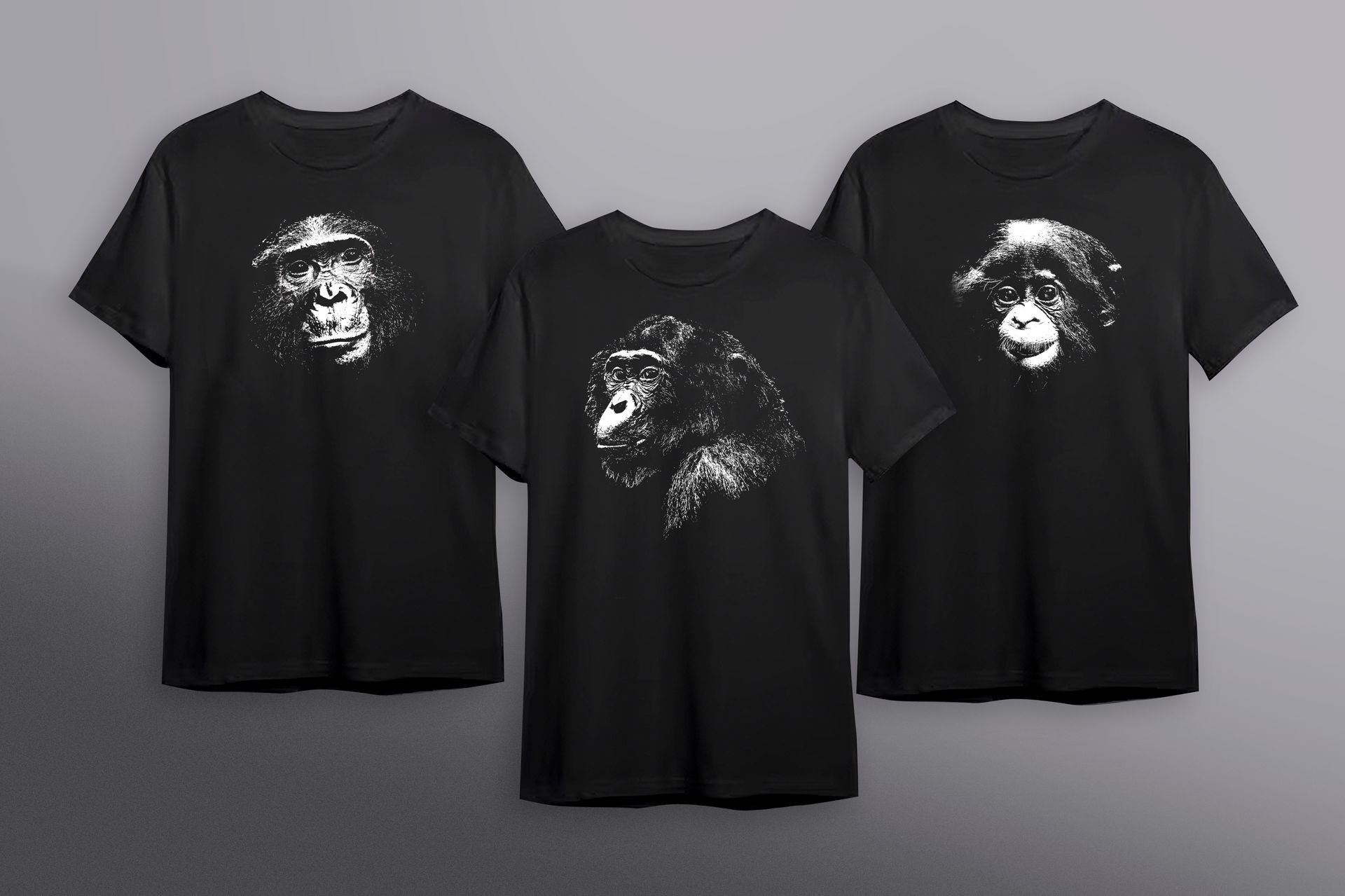
Einen Bonobo für zu Hause Lobbyarbeit ist wichtig – vor allem dann, wenn man seine Ziele ausschließlich über Spenden erreichen kann. Und es sind neue Gesichter, die für die Aktionen von Bonobo Alive werben. Portraits von Iris (links), Dango (mitte) und Parvati (rechts) schmücken die neuen T-Shirts, die ab April verfügbar sein werden. Für die professionelle Gestaltung konnte der Verein das in Dresden beheimatete Design- und Medienstudio RODEORATIO ( https://rodeoratio.de/ ) gewinnen. Nachdem klar war, welchen Zweck die Aktion verfolgt, entschied sich RODEORATIO spontan, die Leistung dem Verein als Spende zukommen zu lassen und trägt so auf seine Weise zum Arten- und Naturschutz bei. A bonobo for your home Lobbying is important - especially when you can only achieve your goals through donations. And there are new faces promoting this campaign of Bonobo Alive. Portraits of Iris (left), Dango (center), and Parvati (right) adorn the new T-shirts, which will be available from April onwards. To realize the initiative, Bonobo Alive was able to win over the Dresden-based design and media studio RODEORATIO ( https://rodeoratio.de/ ) for the professional design. Once it was clear what the purpose of the campaign was, RODEORATIO spontaneously decided to contribute its service as a donation and, by doing so, participate in species and nature conservation in its own way.
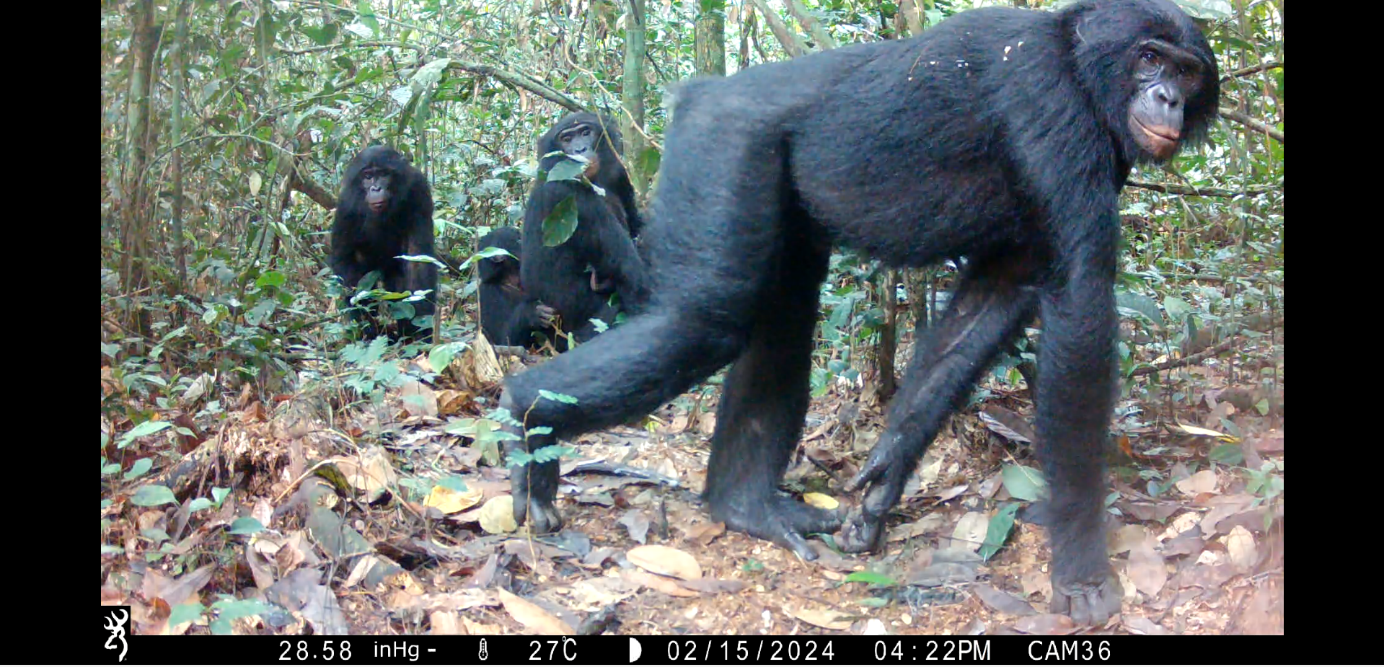
Bestandsaufnahme im Salonga ( Bild 1 ) Das Überleben vieler Wildtiere ist akut bedroht. Überall auf der Welt sind Forscher und Naturschützer unterwegs, um Populationszählungen durchzuführen und so den Grad der Bedrohung mit Zahlen zu belegen. Die Ergebnisse derartiger Volkszählungen geben Auskunft über den derzeitigen Status quo. Noch wichtiger als aktuelle Zahlen sind Trendabschätzungen, wie sich Wildtierbestände über bestimmte Zeiträume ändern. Verlässliche Zahlen die solche Rückschlüsse erlauben sind jedoch vergleichsweise selten. Erstens sind Bestandszählungen logistisch aufwendig und kostspielig. Zweitens kommen oftmals unterschiedliche Methoden zum Einsatz weshalb die Ergebnisse aus Studie A nicht unbedingt mit denen von Studie B vergleichbar sind. Drittens konzentrieren sich Zählungen bevorzugt auf kleine Arealen und werden dann auf größere Gebiete übertragen, eine Methode die fehleranfällig ist. Eine im Dezember 2024 veröffentlichte Studie präsentiert Zahlen zur Bestandsentwicklung der Bonobo-Population im Salonga Nationalpark . Anders als früheren Arbeiten berücksichtigte Mattia Bessone ( Bild 2 ) und seine Koautoren in ihrer Analyse Bestandszahlen, die über einen langen Zeitraum und an unterschiedlichen Standorten des Parks aufgenommen wurden. Die Studie kommt zu dem Schluss, dass der Salonga nach wie vor Heimat einer der größten Bonobo-Populationen ist und damit für den Schutz dieser Menschenaffenart einen besonderen Stellenwert hat. Allerdings deuten die Zahlen auf einen Rückgang der Population hin. Die bisherigen Schutzmaßnahmen reichen demnach nicht aus, Bonobos in dem größten Schutzgebiet der Cuvette Central zu schützen. Wie viele Bonobos in den Wäldern südlich des Kongoflusses leben ist nicht bekannt und Schutzbemühungen werden sich auch in Zukunft auf jene Wälder konzentrieren, die unter der Kontrolle der kongolesischen Naturschutzbehörde stehen. Eine Strategie, die bislang kaum Beachtung findet wäre, die Pufferzone, die den Park umgibt mit Hilfe der dort siedelnden Bevölkerung zu nutzen. Zum einen würden davon unmittelbar die dort lebenden Bonobos profitieren. Andererseits wäre das ein zusätzliches Mittel, Jägern daran zu hindern, in das Schutzgebiet einzudringen. Zusätzlichen man power für den Bonoboschutz zu rekrutieren kann, dass zeigen die jahrelangen Bemühungen von Bonobo Alive, den Lebensraum der Menschenaffen und anderer bedrohter Arten sicherer machen.
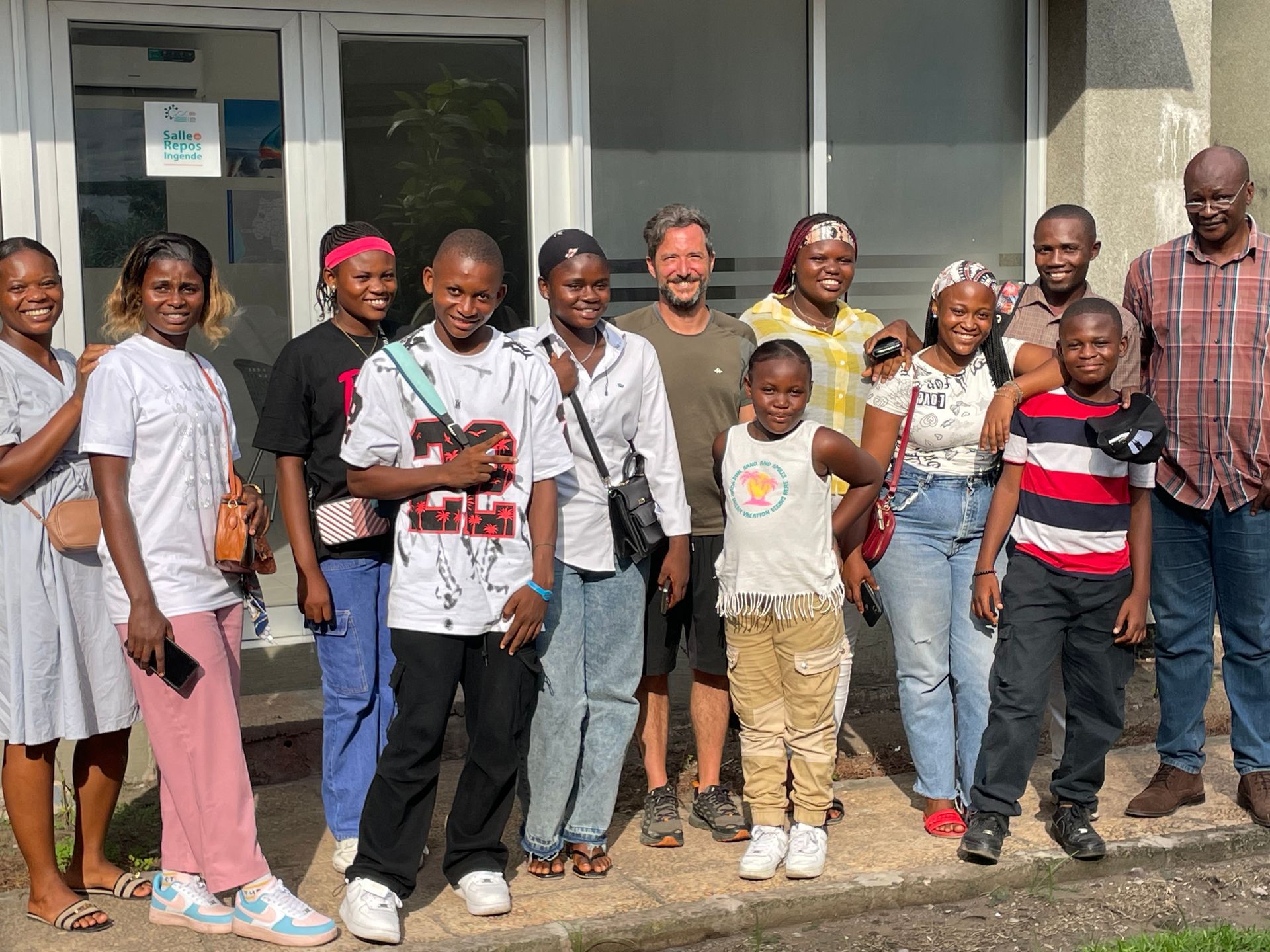
Bildungsförderung ist ein wichtiges Element im Portfolio von Bonobo Alive. Die Möglichkeiten zur Aus- und Weiterbildung sind im ländlichen Raum besonders rar; der Schulbetrieb steht generell auf schwachen Füssen, endet früh und die Infrastruktur für diejenigen, die ihre Ausbildung fortsetzen möchten, fehlt.


